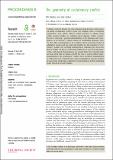Files in this item
The geometry of evolutionary conflict
Item metadata
| dc.contributor.author | Rautiala, Petri Tapio | |
| dc.contributor.author | Gardner, Andy | |
| dc.date.accessioned | 2023-02-08T10:30:08Z | |
| dc.date.available | 2023-02-08T10:30:08Z | |
| dc.date.issued | 2023-02-08 | |
| dc.identifier | 282894943 | |
| dc.identifier | dec6866b-b7f8-45e0-94ea-754bc8048fa1 | |
| dc.identifier | 85147621273 | |
| dc.identifier.citation | Rautiala , P T & Gardner , A 2023 , ' The geometry of evolutionary conflict ' , Proceedings of the Royal Society of London Series B: Biological Sciences , vol. 290 , no. 1992 , 20222423 . https://doi.org/10.1098/rspb.2022.2423 | en |
| dc.identifier.issn | 0962-8452 | |
| dc.identifier.uri | https://hdl.handle.net/10023/26921 | |
| dc.description | Funding: This study was funded by a Natural Environment Research Council Independent Research Fellowship (grant no. NE/K009524/1) and a European Research Council Consolidator Grant (no. 771387). | en |
| dc.description.abstract | Conflicts of interest abound not only in human affairs but also in the biological realm. Evolutionary conflict occurs over multiple scales of biological organization, from genetic outlawry within genomes, to sibling rivalry within nuclear families, to collective-action disputes within societies. However, achieving a general understanding of the dynamics and consequences of evolutionary conflict remains an outstanding challenge. Here, we show that a development of R. A. Fisher's classic ‘geometric model’ of adaptation yields novel and surprising insights into the dynamics of evolutionary conflict and resulting maladaptation, including the discoveries that: (i) conflict can drive evolving traits arbitrarily far away from all parties' optima and, indeed, if all mutations are equally likely then contested traits are more often than not driven outwith the zone of actual conflict (hyper-maladaptation); (ii) evolutionary conflicts drive persistent maladaptation of orthogonal, non-contested traits (para-maladaptation); and (iii) modular design greatly ameliorates conflict-driven maladaptation, thereby facilitating major transitions in individuality. | |
| dc.format.extent | 7 | |
| dc.format.extent | 771420 | |
| dc.language.iso | eng | |
| dc.relation.ispartof | Proceedings of the Royal Society of London Series B: Biological Sciences | en |
| dc.subject | Cost of complexity | en |
| dc.subject | Maladaptation | en |
| dc.subject | Modularity | en |
| dc.subject | Major transitions | en |
| dc.subject | Fisher's geometric model | en |
| dc.subject | Conflict | en |
| dc.subject | QH301 Biology | en |
| dc.subject | DAS | en |
| dc.subject | MCC | en |
| dc.subject.lcc | QH301 | en |
| dc.title | The geometry of evolutionary conflict | en |
| dc.type | Journal article | en |
| dc.contributor.sponsor | European Research Council | en |
| dc.contributor.sponsor | NERC | en |
| dc.contributor.institution | University of St Andrews. School of Biology | en |
| dc.contributor.institution | University of St Andrews. St Andrews Bioinformatics Unit | en |
| dc.contributor.institution | University of St Andrews. Institute of Behavioural and Neural Sciences | en |
| dc.contributor.institution | University of St Andrews. Centre for Biological Diversity | en |
| dc.identifier.doi | 10.1098/rspb.2022.2423 | |
| dc.description.status | Peer reviewed | en |
| dc.identifier.grantnumber | 771387 | en |
| dc.identifier.grantnumber | NE/K009524/1 | en |
This item appears in the following Collection(s)
Items in the St Andrews Research Repository are protected by copyright, with all rights reserved, unless otherwise indicated.

